
Illustrative Math Alignment: Grade 6 Unit 1
Expressions and Equations
Lesson 6: Write Expressions Where Letters Stand for Numbers
Use the following Media4Math resources with this Illustrative Math lesson.
| Thumbnail Image | Title | Body | Curriculum Nodes |
|---|---|---|---|
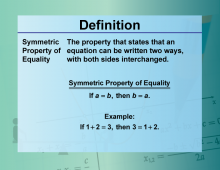
|
Definition--Equation Concepts--Symmetric Property of Equality | Symmetric Property of EqualityTopicEquations DefinitionThe Symmetric Property of Equality states that if a = b, then b = a. DescriptionThe Symmetric Property of Equality is a basic principle in mathematics. It asserts that the equality relation is symmetric, meaning that if one quantity equals another, then the second quantity equals the first. For example, if x = y then y = x This property is used to justify steps in solving equations and proving mathematical statements. |
Applications of Equations and Inequalities |

|
Definition--Equation Concepts--The Unknown | The UnknownTopicEquations DefinitionThe unknown is the variable in an equation that needs to be solved for. DescriptionThe unknown in an equation represents the value that needs to be determined. For example, in the equation x + 3 = 7 x is the unknown. Identifying and solving for the unknown is a core aspect of algebra. In real-world applications, finding the unknown is crucial for solving problems in various fields such as science, engineering, and finance. Understanding how to identify and solve for the unknown helps students develop problem-solving skills and apply mathematical concepts to real-life situations. |
Variables and Unknowns |
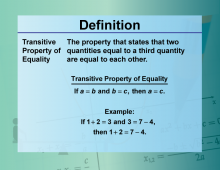
|
Definition--Equation Concepts--Transitive Property of Equality | Transitive Property of EqualityTopicEquations DefinitionThe Transitive Property of Equality states that if a = b and b = c, then a = c. DescriptionThe Transitive Property of Equality is a fundamental principle in mathematics. It states that if one quantity equals a second quantity, and the second quantity equals a third, then the first and third quantities are equal. For example, if x = y and y = z then x = z This property is used to justify steps in solving equations and proving mathematical statements. |
Applications of Equations and Inequalities |
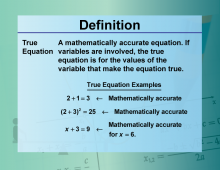
|
Definition--Equation Concepts--True Equation | True EquationTopicEquations DefinitionA true equation is an equation that holds true for the given values of the variable(s). DescriptionA true equation is an equation that is valid for specific values of the variable(s). For example, the equation 2 + 3 = 5 is true because both sides are equal. Identifying true equations is important in verifying the correctness of mathematical statements. In real-world applications, recognizing true equations helps in ensuring the accuracy of mathematical models and solutions. Understanding true equations helps students develop critical thinking and analytical skills. |
Applications of Equations and Inequalities |
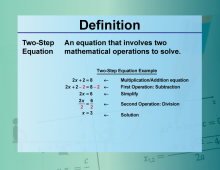
|
Definition--Equation Concepts--Two-Step Equation | Two-Step EquationTopicEquations DefinitionA two-step equation requires two operations to solve. DescriptionTwo-step equations involve performing two operations to isolate the variable. For example, solving 2x + 3 = 7 requires subtracting 3 from both sides and then dividing by 2 to find x = 2. These equations are common in algebra and require a systematic approach to solve. In real-world applications, two-step equations are used in problem-solving scenarios such as calculating costs or determining measurements. Understanding how to solve two-step equations helps students develop critical thinking and problem-solving skills. |
Solving Two-Step Equations |
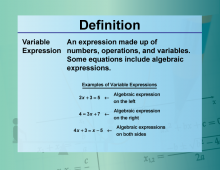
|
Definition--Equation Concepts--Variable Expression | Variable ExpressionTopicEquations DefinitionA variable expression is a mathematical phrase involving variables, numbers, and operation symbols. DescriptionVariable expressions consist of variables, numbers, and operations such as addition, subtraction, multiplication, and division. For example, 3x + 4 is a variable expression. These expressions are used to represent quantities and relationships in algebra. |
Variable Expressions |
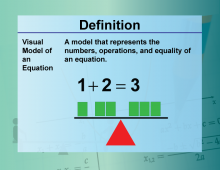
|
Definition--Equation Concepts--Visual Models for Equations | Visual Models for EquationsTopicEquations DefinitionVisual models for equations use graphical representations to illustrate the relationships between variables. DescriptionVisual models for equations include graphs, charts, and diagrams that represent the relationships between variables. For example, a graph of the equation y = 2x + 3 shows a straight line with a slope of 2 and a y-intercept of 3. These models help in understanding and interpreting equations. |
Applications of Equations and Inequalities |
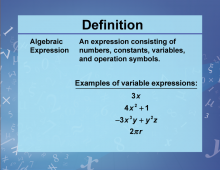
|
Definition--Variables, Unknowns, and Constants--Algebraic Expression | Definition--Variables, Unknowns, and Constants--Algebraic Expression
This is part of a collection of definitions related to variables, unknowns, and constants. This includes general definitions for variables, unknowns, and constants, as well as related terms that describe their properties. |
Variables and Unknowns |
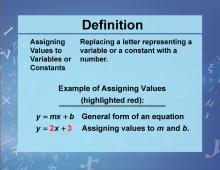
|
Definition--Variables, Unknowns, and Constants--Assigning Values to Variables | Definition--Variables, Unknowns, and Constants--Assigning Values to Variables
This is part of a collection of definitions related to variables, unknowns, and constants. This includes general definitions for variables, unknowns, and constants, as well as related terms that describe their properties. |
Variables and Unknowns |
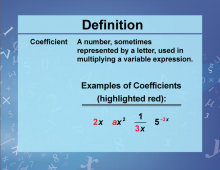
|
Definition--Variables, Unknowns, and Constants--Coefficient | What Is a Coefficient?
This is part of a series of definitions that focus on constants, variables, and coefficients. These definition cards can easily be incorporated into a lesson plan. —PRESS PREVIEW TO SEE THE DEFINITION— To see the complete collection of definitions on this topic, click on this link.The following section provides a brief review of number properties that are helpful in working with numerical and variable expressions. |
Variables and Unknowns |
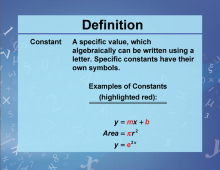
|
Definition--Variables, Unknowns, and Constants--Constant | Definition--Variables, Unknowns, and Constants--Constant
This is part of a collection of definitions related to variables, unknowns, and constants. This includes general definitions for variables, unknowns, and constants, as well as related terms that describe their properties. |
Variables and Unknowns |
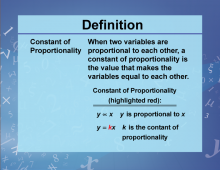
|
Definition--Variables, Unknowns, and Constants--Constant of Proportionality | Definition--Variables, Unknowns, and Constants--Constant of Proportionality
This is part of a collection of definitions related to variables, unknowns, and constants. This includes general definitions for variables, unknowns, and constants, as well as related terms that describe their properties. |
Variables and Unknowns |
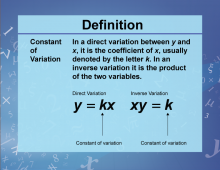
|
Definition--Variables, Unknowns, and Constants--Constant of Variation | Definition--Variables, Unknowns, and Constants--Constant of Variation
This is part of a collection of definitions related to variables, unknowns, and constants. This includes general definitions for variables, unknowns, and constants, as well as related terms that describe their properties. |
Variables and Unknowns |

|
Definition--Variables, Unknowns, and Constants--Constant Term | Definition--Variables, Unknowns, and Constants--Constant Term
This is part of a collection of definitions related to variables, unknowns, and constants. This includes general definitions for variables, unknowns, and constants, as well as related terms that describe their properties. |
Variables and Unknowns |
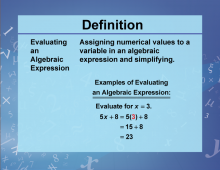
|
Definition--Variables, Unknowns, and Constants--Evaluating an Algebraic Expression | Definition--Variables, Unknowns, and Constants--Evaluating an Algebraic Expression
This is part of a collection of definitions related to variables, unknowns, and constants. This includes general definitions for variables, unknowns, and constants, as well as related terms that describe their properties. |
Variables and Unknowns |
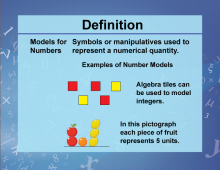
|
Definition--Variables, Unknowns, and Constants--Models for Numbers | Definition--Variables, Unknowns, and Constants--Models for Numbers
This is part of a collection of definitions related to variables, unknowns, and constants. This includes general definitions for variables, unknowns, and constants, as well as related terms that describe their properties. |
Variables and Unknowns |
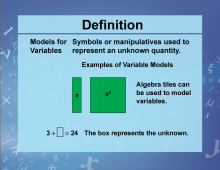
|
Definition--Variables, Unknowns, and Constants--Models for Variables | Definition--Variables, Unknowns, and Constants--Models for Variables
This is part of a collection of definitions related to variables, unknowns, and constants. This includes general definitions for variables, unknowns, and constants, as well as related terms that describe their properties. |
Variables and Unknowns |
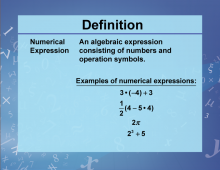
|
Definition--Variables, Unknowns, and Constants--Numerical Expression | Definition--Variables, Unknowns, and Constants--Numerical Expression
This is part of a collection of definitions related to variables, unknowns, and constants. This includes general definitions for variables, unknowns, and constants, as well as related terms that describe their properties. |
Variables and Unknowns |

|
Definition--Variables, Unknowns, and Constants--Parameter | Definition--Variables, Unknowns, and Constants--Parameter
This is part of a collection of definitions related to variables, unknowns, and constants. This includes general definitions for variables, unknowns, and constants, as well as related terms that describe their properties. |
Variables and Unknowns |

|
Definition--Variables, Unknowns, and Constants--Random Variable | Definition--Variables, Unknowns, and Constants--Random Variable
This is part of a collection of definitions related to variables, unknowns, and constants. This includes general definitions for variables, unknowns, and constants, as well as related terms that describe their properties. |
Variables and Unknowns |
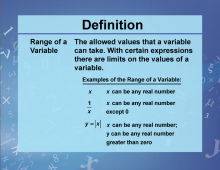
|
Definition--Variables, Unknowns, and Constants--Range of a Variable | Definition--Variables, Unknowns, and Constants--Range of a Variable
This is part of a collection of definitions related to variables, unknowns, and constants. This includes general definitions for variables, unknowns, and constants, as well as related terms that describe their properties. |
Variables and Unknowns |
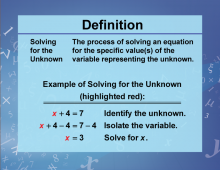
|
Definition--Variables, Unknowns, and Constants--Solving for the Unknown | Definition--Variables, Unknowns, and Constants--Solving for the Unknown
This is part of a collection of definitions related to variables, unknowns, and constants. This includes general definitions for variables, unknowns, and constants, as well as related terms that describe their properties. |
Variables and Unknowns |
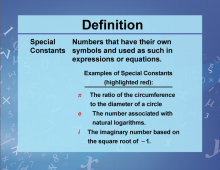
|
Definition--Variables, Unknowns, and Constants--Special Constants | Definition--Variables, Unknowns, and Constants--Special Constants
This is part of a collection of definitions related to variables, unknowns, and constants. This includes general definitions for variables, unknowns, and constants, as well as related terms that describe their properties. |
Variables and Unknowns |
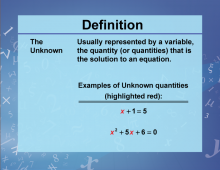
|
Definition--Variables, Unknowns, and Constants--Unknown | Definition--Variables, Unknowns, and Constants--Unknown
This is part of a collection of definitions related to variables, unknowns, and constants. This includes general definitions for variables, unknowns, and constants, as well as related terms that describe their properties. |
Variables and Unknowns |
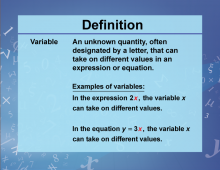
|
Definition--Variables, Unknowns, and Constants--Variable | Definition | Variables, Unknowns, and Constants | Variable
This is part of a collection of definitions on the topic of variables and constants. These definitions can easily be incorporated into your lesson plans. —PRESS PREVIEW TO SEE THE DEFINITION— To see the complete collection of definitions on this topic, click on this link.The following section provides additional information on the topic. Watch this video about variables and equations. (The transcript is included.) |
Variables and Unknowns |

|
Definition--Variables, Unknowns, and Constants--Variable Expression | Definition--Variables, Unknowns, and Constants--Variable Expression
This is part of a collection of definitions related to variables, unknowns, and constants. This includes general definitions for variables, unknowns, and constants, as well as related terms that describe their properties. |
Variables and Unknowns |
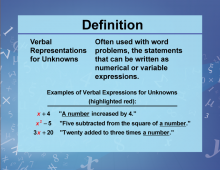
|
Definition--Variables, Unknowns, and Constants--Verbal Representations for Unknowns | Definition--Variables, Unknowns, and Constants--Verbal Representations for Unknowns
This is part of a collection of definitions related to variables, unknowns, and constants. This includes general definitions for variables, unknowns, and constants, as well as related terms that describe their properties. |
Variables and Unknowns |

|
INSTRUCTIONAL RESOURCE: Math Examples 13 | INSTRUCTIONAL RESOURCE: Math Examples--Equations with Fractions
The complete set of 13 examples that make up this set of tutorials. This is part of a collection of math examples for a variety of math topics. To see the complete collection of these resources, click on this link. Note: The download is a PPT file.Library of Instructional ResourcesTo see the complete library of Instructional Resources , click on this link. |
Solving Fraction Equations |

|
INSTRUCTIONAL RESOURCE: Math Examples 14 | INSTRUCTIONAL RESOURCE: Math Examples--Equations with Percents
The complete set of 42 examples that make up this set of tutorials. This is part of a collection of math examples for a variety of math topics. To see the complete collection of these resources, click on this link. Note: The download is a PPT file.Library of Instructional ResourcesTo see the complete library of Instructional Resources , click on this link. |
Solving Percent Equations |

|
INSTRUCTIONAL RESOURCE: Math Examples 34 | INSTRUCTIONAL RESOURCE: Math Examples--One-Variable Equations
The complete set of 21 examples that make up this set of tutorials. This is part of a collection of math examples for a variety of math topics. To see the complete collection of these resources, click on this link. Note: The download is a PPT file.Library of Instructional ResourcesTo see the complete library of Instructional Resources , click on this link. |
Applications of Equations and Inequalities |
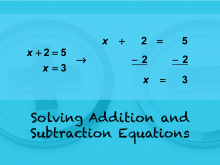
|
INSTRUCTIONAL RESOURCE: Tutorial: Solving Addition and Subtraction Equations | INSTRUCTIONAL RESOURCE: Tutorial: Solving Addition and Subtraction Equations
Learn how to solve addition and subtraction equations using column addition and subtraction techniques. This is part of a collection of math tutorials on a variety of math topics. To see the complete collection of these resources, click on this link.Library of Instructional ResourcesTo see the complete library of Instructional Resources , click on this link. |
Addition Expressions and Equations and Subtraction Expressions and Equations |

|
INSTRUCTIONAL RESOURCE: Tutorial: What Is an Equation? | INSTRUCTIONAL RESOURCE: Tutorial: What Is an Equation?
An equation shows a relationship between two quantities. Note: The download is a PDF. This is part of a collection of math tutorials on a variety of math topics. To see the complete collection of these resources, click on this link.Library of Instructional ResourcesTo see the complete library of Instructional Resources , click on this link. |
Applications of Equations and Inequalities and Variables and Unknowns |
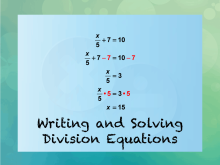
|
INSTRUCTIONAL RESOURCE: Tutorial: Writing and Solving Division Equations | INSTRUCTIONAL RESOURCE: Tutorial: Writing and Solving Division Equations
This tutorial provides an overview of solving division equations, with the focus on one- and two-step equations. This is part of a collection of math tutorials on a variety of math topics. To see the complete collection of these resources, click on this link.Library of Instructional ResourcesTo see the complete library of Instructional Resources , click on this link. |
Division Expressions and Equations |
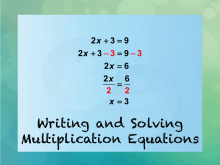
|
INSTRUCTIONAL RESOURCE: Tutorial: Writing and Solving Multiplication Equations | INSTRUCTIONAL RESOURCE: Tutorial: Writing and Solving Multiplication Equations
This tutorial provides an overview of writing and solving multiplication equations. The focus is on one- and two-step equations. This is part of a collection of math tutorials on a variety of math topics. To see the complete collection of these resources, click on this link.Library of Instructional ResourcesTo see the complete library of Instructional Resources , click on this link. |
Multiplication Expressions and Equations |

|
INSTRUCTIONAL RESOURCE: Tutorial: Variables and Variable Expressions | INSTRUCTIONAL RESOURCE: Tutorial: Variables and Variable Expressions
In this Slide Show, learn about variables and variable expressions. This is part of a collection of tutorials on a variety of math topics. To see the complete collection of these resources, click on this link. Note: The download is a PPT file.< Library of Instructional ResourcesTo see the complete library of Instructional Resources , click on this link. |
Variable Expressions, Applications of Equations and Inequalities and Variables and Unknowns |
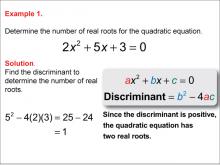
|
Math Example--Quadratics--Calculating the Discriminant: Example 1 | Calculating the Discriminant: Example 1TopicQuadratics |
Quadratic Formula |
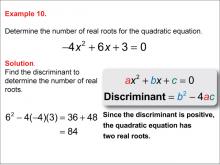
|
Math Example--Quadratics--Calculating the Discriminant: Example 10 | Calculating the Discriminant: Example 10TopicQuadratics DescriptionThis example illustrates a quadratic with two real roots. The discriminant being positive indicates that there are two real solutions to the equation. This scenario helps students recognize the significance of repeated roots and their graphical representation. For a complete collection of math examples related to Quadratics click on this link: Math Examples: Quadratics Collection. |
Quadratic Formula |
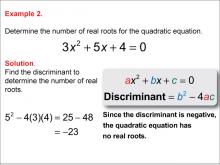
|
Math Example--Quadratics--Calculating the Discriminant: Example 2 | Calculating the Discriminant: Example 2TopicQuadratics |
Quadratic Formula |
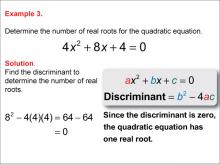
|
Math Example--Quadratics--Calculating the Discriminant: Example 3 | Calculating the Discriminant: Example 3TopicQuadratics DescriptionThis example demonstrates a quadratic equation with one distinct real root, highlighting the relationship between the coefficients and the resulting discriminant. By calculating the discriminant, students can identify the nature of the roots, which is crucial for solving quadratics effectively. Skills involved include algebraic manipulation and understanding the graphical implications of roots. For a complete collection of math examples related to Quadratics click on this link: Math Examples: Quadratics Collection. |
Quadratic Formula |

|
Math Example--Quadratics--Calculating the Discriminant: Example 4 | Calculating the Discriminant: Example 4TopicQuadratics DescriptionThis example illustrates a quadratic with two real roots. The discriminant being positive indicates that there are two real roots. This scenario helps students recognize the significance of repeated roots and their graphical representation. For a complete collection of math examples related to Quadratics click on this link: Math Examples: Quadratics Collection. |
Quadratic Formula |

|
Math Example--Quadratics--Calculating the Discriminant: Example 5 | Calculating the Discriminant: Example 5TopicQuadratics DescriptionThis example demonstrates a quadratic equation with no distinct real roots, highlighting the relationship between the coefficients and the resulting discriminant. By calculating the discriminant, students can identify the nature of the roots, which is crucial for solving quadratics effectively. Skills involved include algebraic manipulation and understanding the graphical implications of roots. For a complete collection of math examples related to Quadratics click on this link: Math Examples: Quadratics Collection. |
Quadratic Formula |
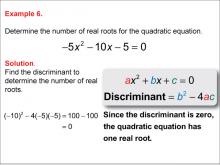
|
Math Example--Quadratics--Calculating the Discriminant: Example 6 | Calculating the Discriminant: Example 6TopicQuadratics DescriptionThis example illustrates a quadratic with a double real root. The discriminant being zero indicates that there is exactly one real solution to the equation. This scenario helps students recognize the significance of repeated roots and their graphical representation. For a complete collection of math examples related to Quadratics click on this link: Math Examples: Quadratics Collection. |
Quadratic Formula |
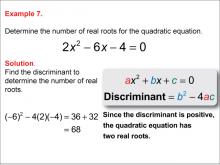
|
Math Example--Quadratics--Calculating the Discriminant: Example 7 | Calculating the Discriminant: Example 7TopicQuadratics DescriptionIn this example, the quadratic equation results in two roots, demonstrating the cases where the discriminant is positive. This provides insights into scenarios where quadratic equations intersect the x-axis twice. Skills in algebra are focused on interpreting complex solutions and their geometric implications. For a complete collection of math examples related to Quadratics click on this link: Math Examples: Quadratics Collection. |
Quadratic Formula |

|
Math Example--Quadratics--Calculating the Discriminant: Example 8 | Calculating the Discriminant: Example 8TopicQuadratics DescriptionThis example illustrates a quadratic with two real roots. The discriminant being positive indicates that there are two real solutions to the equation. This scenario helps students recognize the significance of two roots and their graphical representation. For a complete collection of math examples related to Quadratics click on this link: Math Examples: Quadratics Collection. |
Quadratic Formula |
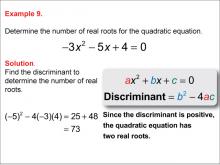
|
Math Example--Quadratics--Calculating the Discriminant: Example 9 | Calculating the Discriminant: Example 9TopicQuadratics DescriptionThis example demonstrates a quadratic equation with two distinct real roots, highlighting the relationship between the coefficients and the resulting discriminant. By calculating the discriminant, students can identify the nature of the roots, which is crucial for solving quadratics effectively. Skills involved include algebraic manipulation and understanding the graphical implications of roots. For a complete collection of math examples related to Quadratics click on this link: Math Examples: Quadratics Collection. |
Quadratic Formula |

|
Math Example--Ratios, Proportions, and Percents--Solving Proportions: Example 1 | Math Example--Ratios, Proportions, and Percents--Solving Proportions: Example 1TopicRatios, Proportions, and Percents DescriptionThis example demonstrates how to solve a proportion problem where two ratios a:b and c:d are proportional. Given the values b = 3, c = 4, and d = 6, we need to find the value of a. The proportion is set up as a / 3 = 4 / 6, which is then solved to find that a = 2. |
Proportions |
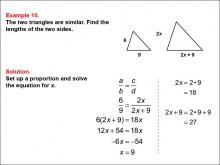
|
Math Example--Ratios, Proportions, and Percents--Solving Proportions: Example 10 | Math Example--Ratios, Proportions, and Percents--Solving Proportions: Example 10TopicRatios, Proportions, and Percents DescriptionThis example illustrates solving a proportion problem using similar triangles with algebraic expressions. Two triangles are shown, one with sides of 6 and 9, and the other with sides of 2x and 2x + 9. The problem requires setting up a proportion: 6 / 9 = 2x / (2x + 9). Solving this equation leads to x = 9, which then allows us to find the side lengths of 18 and 27. |
Proportions |
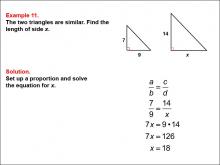
|
Math Example--Ratios, Proportions, and Percents--Solving Proportions: Example 11 | Math Example--Ratios, Proportions, and Percents--Solving Proportions: Example 11TopicRatios, Proportions, and Percents DescriptionThis example demonstrates solving a proportion problem using similar right triangles. Two right triangles are shown, one with legs of 7 and 9, and the other with legs of 14 and x. The problem requires finding the length of side x by setting up a proportion based on the similar triangles: 7 / 9 = 14 / x. Solving this equation leads to x = 18. |
Proportions |
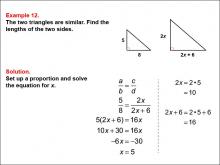
|
Math Example--Ratios, Proportions, and Percents--Solving Proportions: Example 12 | Math Example--Ratios, Proportions, and Percents--Solving Proportions: Example 12TopicRatios, Proportions, and Percents DescriptionThis example illustrates solving a proportion problem using similar right triangles with algebraic expressions. Two right triangles are shown, one with legs of 5 and 8, and the other with legs of 2x and (2x + 6). The problem requires setting up a proportion: 5 / 8 = 2x / (2x + 6). Solving this equation leads to x = 5, which then allows us to find the side lengths of 10 and 16. |
Proportions |

|
Math Example--Ratios, Proportions, and Percents--Solving Proportions: Example 13 | Math Example--Ratios, Proportions, and Percents--Solving Proportions: Example 13TopicRatios, Proportions, and Percents DescriptionThis example demonstrates solving a proportion problem using similar right triangles with special angles (30°-60°-90°). Two triangles are shown, with the smaller one having sides of 6√3 and 6, and the larger one having sides of x and 12. The problem requires finding the length of side x by setting up a proportion: (6√3) / 6 = x / 12. Solving this equation leads to x = 12√3. |
Proportions |